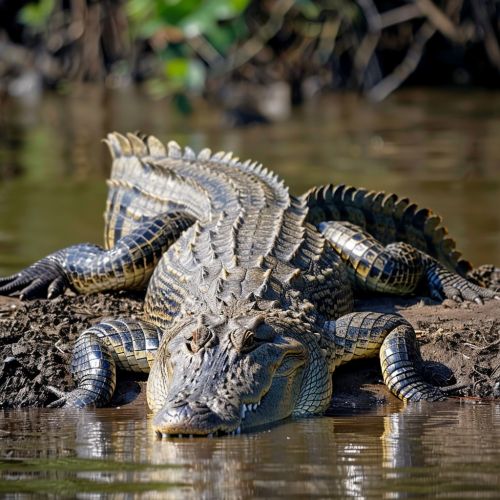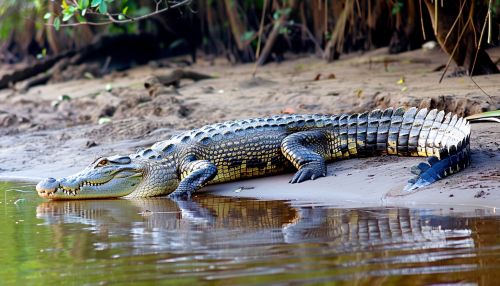Saltwater Crocodile
Introduction
The Saltwater Crocodile (Crocodylus porosus) is the largest living reptile and a formidable apex predator. This species is found in suitable habitats from northern Australia through Southeast Asia to the eastern coast of India. Known for its size, strength, and aggressive nature, the saltwater crocodile is a subject of extensive scientific research and conservation efforts.
Taxonomy and Evolution
Saltwater crocodiles belong to the family Crocodylidae, which includes other large crocodilian species. The genus Crocodylus is characterized by a V-shaped snout and robust body. Fossil records indicate that the saltwater crocodile's ancestors date back to the Late Cretaceous period, approximately 100 million years ago. Phylogenetic studies suggest that Crocodylus porosus diverged from other crocodilian species around 12 million years ago.
Physical Characteristics
Saltwater crocodiles are distinguished by their massive size, with males reaching lengths of up to 7 meters and weights of over 1,000 kilograms. Females are smaller, typically growing to about 3 meters. Their skin is covered in tough, scaly armor, providing protection and aiding in thermoregulation. The coloration varies from grey to dark green, with a lighter underbelly.


Habitat and Distribution
Saltwater crocodiles inhabit a range of environments, including estuaries, rivers, lakes, and coastal areas. They are highly adaptable and can tolerate both freshwater and saltwater, allowing them to occupy diverse habitats. Their distribution spans from the eastern coast of India, through Southeast Asia, to northern Australia. They are particularly abundant in the mangrove swamps and river deltas of these regions.
Behavior and Ecology
Saltwater crocodiles are solitary and territorial animals. They are known for their ambush hunting technique, lying in wait for prey to come within striking distance. Their diet consists of fish, birds, mammals, and occasionally other reptiles. Juveniles primarily feed on insects and small aquatic animals. As apex predators, they play a crucial role in maintaining the balance of their ecosystem by controlling the population of prey species.
Reproduction
Breeding season for saltwater crocodiles typically occurs during the wet season. Females build nests from vegetation and mud, where they lay between 40 to 60 eggs. The incubation period lasts about 90 days, with the temperature of the nest determining the sex of the hatchlings. Females exhibit parental care by guarding the nest and assisting the hatchlings to water once they emerge.
Conservation Status
The saltwater crocodile is listed under Appendix I of the Convention on International Trade in Endangered Species of Wild Fauna and Flora (CITES), which restricts international trade of the species. Despite being hunted extensively in the past for their valuable skin, conservation efforts have led to a significant recovery in their populations. However, habitat destruction and human-crocodile conflict continue to pose threats.
Human Interaction
Saltwater crocodiles have a notorious reputation for being dangerous to humans. Attacks are rare but often fatal due to the crocodile's immense power and stealth. In regions where human activities overlap with crocodile habitats, management strategies are implemented to minimize conflict. These include public education, habitat modification, and in some cases, relocation of problem individuals.
Research and Studies
Ongoing research on saltwater crocodiles covers various aspects, including their physiology, behavior, and genetics. Studies on their salt tolerance mechanisms have provided insights into their ability to thrive in diverse environments. Genetic research has also helped in understanding population structures and guiding conservation strategies.
